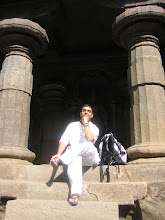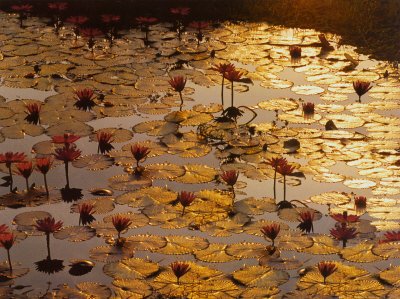In Jan. '08, I had the great fortune to visit the famous cave temples of
Ellora with my mother. Below is my account of the trip.

It was just after 10 in the morning yet the sun was already bearing down on us. The
Deccan landscape reminded me of the sweeping landscapes found in Old Western movies, be they spaghetti or otherwise. After much planning and anticipation we were finally here, standing at the threshold to the Ellora caves. Wow.

Our "base camp" was the
WelcomeRama, a nice hotel situated near the Aurangabad airport.
Aurangabad itself is a city with a long and fascinating history. Located in
Maharashrashtra state and a quick 45 min plane ride from Mumbai, Aurangabad and
it's surrounding areas, I dare say, emcompass almost all the major phases of Indian history. In addition to famous Hindu temples, Sufi shrines, and the Jain/Hindu/Buddhist cave temples of Ajanta and Ellora , you'll also find the tomb of the last great Mughal emperor,
Aurangzeb (from which the city takes it name).
Nowadays, it's an up and coming boom-town on the forefront of India's development but still pays homage to it's glorious past with the annual
Ellora-Ajanta Festival.
After breakfast, we met up with our driver (a pleasant local fellow) and arranged the details of our excursion: a trip to Ellora with a visit to
Daulatabad Fortress on the way back. I then decided I'd break the ice and practice my Hindi a bit. Although
Marathi is the local language,
Hindi (as well as English) is widely spoken too.
Me: "Driver-sahab, Apka naam kya hai? - ड्राईवर सहब, आपका नाम क्या है?"
(Driver-Sir, what's your name?)
Javed-Sahab: "Oho! Hindi-bolte?! Accha Accha! Maing Javed Mohammed Aktar hoon. - ओहो! हिन्दी बोलते?! अच्छा अच्छा। मैँ जावेद महोम्मेद अख़तर हूँ।
(Oh! You speak Hindi huh? Great! I'm Javed Mohammed Akhtar.)
After some brief cordial talk, I then switched the topic to one of utmost seriousness.
Me: "Aapko Amitabh Bachchan pasand hai? - आपको अमिताभ बच्चन पसंद है?"
(Do you like Amitabh Bachchan?)
[the Bollywood Megastar...arguably the most famous man in India]
Javed-Sahab: "Ji, zaroor! Voh sabse accha hai! - जी, ज़रूर! वो सबसे अच्छा है!"
(Of course! He's the greatest!)
 Ellora is comprised of three cave groups
Ellora is comprised of three cave groups, Buddhist, Hindu, and Jain. The Buddhist caves are the oldest (5-7th Century AD), followed by the Hindu ( 7th - 9th Century AD) and Jain caves (8 - 11th Centuries AD). The drive took about 30 minutes and we were dropped off first by the Jain caves. They're neatly tucked away from the Hindu and Buddhist caves which are clustered together.

The thing that immediately caught my attention was the not the statues of
Tirthankars or the big Indian families with rowdy kids but the floor. For most caves, in accordance with Indian tradition (and to help preservation efforts) one's shoes must come off. Walking on the warm and amazingly smooth stone was a very unique experience. I'm not sure if the floors were polished by the builders or if the rock is naturally this smooth but I really felt "grounded' in the most literal sense. Although it was the "winter season" in India, the temperatures even in the late morning were a toasty 80°F (27°C) but the sensation of my feet on the smooth, warm stone floor was very pleasant.


My initial feeling of wandering through the caves with my mom was one of pure wonder. The alternation between peaceful, silent, stillness and waves noise (courtesy of the previously mentioned 'wild child' gang, boisterous school kids, and miscellaneous loud mouthed folks) was an interesting contrast that recurred throughout all the sites of Ellora.


Having explored the Jain caves, we then took a quick drive down to the "main site" to visit what is probably the biggest star of Ellora:
Kailash Temple (कैलाश मंदिर). Built over a period of 150 years, there are two immediately striking things about it. The first is that it has a more
South Indian style to it and the second is the entire thing was carved out from a single, giant piece of rock. Reading the last phrase may not seem so awe inspiring but hopefully the photos can give an idea of the massive scale and fine detail the temple is famous for.




Kailash Temple was built to function as a stylized and mystical representation of
Mount Kailash in the Himalayas, where Hindus believe
Lord Shiva dwells. This particular temple is therefore dedicated to Shiva. After exploring much of the "ground level" and side caves, my mom and I headed to the central structure that contained the inner sanctum. A simple room houses a shrine with a
Shiva lingam in the center. A number of people (locals and tourists alike) took the opportunity to offer prayers and enjoy the serenity of a spot far removed from the constant hustle and bustle of the rest of the site. The fact that Kailash Temple was still a "living temple" and not simply an architectural showpiece reminded me that I had come to Ellora (and Ajanta) not really as a tourist but as a pilgrim.


From Kailash Temple, we wandered through some more of the adjacent Hindu caves. Although it was similar to the Jain caves, albeit with Hindu iconography, what I found in one of the caves pleasantly surprised me.

Places like Ellora draw all kinds of visitors from all kinds of backgrounds so I didn't make too much of an elderly Muslim man with four or five of his grandchildren nicely sitting on the floor in the middle of Cave 15. It was also no surprise when they began their noon prayers (
dhuhr -
ظهر) facing Mecca. Watching from afar however, I slowly realized I was witnessing a wonderfully unusual scene that illustrated the beauty of Indian pluralism. Here was a Muslim family praying inside of a Hindu cave with their direction of prayer directly facing the centrally placed Shiva lingam! Almost as if on cue, the family finished their prayers just as a group of French tourists walked in.

The last part of the Ellora visit was to the Buddhist set of caves. We decided it would be more convenient to "go in order" and start with the oldest (and farthest off) cave, Number 1. Although it and the other earlier caves were quite bare, there was a simple, utilitarian beauty to them.

Wandering through the other caves with their amazing sculptures of buddhas, bodhisattvas, and various celestial beings was, in a word, majestic. The rock-cut architectural style made everything seem so...organic, as if the sculptures weren't carved by artisans but rather manifested from the earth itself.

The statues and reliefs have been subjected to centuries of weathering as well as some abuse at human hands but they still effortlessly maintain their serene postures and calm, subduing expressions.

Cave 10 is a unique hall known as the 'Carpenter's Cave'. A seated buddha in the teaching pose (Dharmacakra Mudra) as well as the unique style of the hall itself (more reminiscent of the older caves at Ajanta) make it the most famous Buddhist cave of Ellora.

My personal favorite of all the caves would have to be Cave 12, called teen tal (तीन ताल), meaning 'three floors'. The uppermost floor contains rows of bodhisattvas flanking a row of buddhas on the center of the hall.



Aside from the beauty and arrangement of the sculptures themselves, another thing that moved me was thinking about the long history of the caves. For centuries, people  who had completely devoted their lives to the Buddhadharma studied, prayed, meditated, worked, and lived right were I was walking around. Thinking about this made me reflect on a question that popped up in my head while wandering the Red Fort in Agra (the former capital of Mughal India) a week earlier: what condition will our cities, schools, and landmarks be in thousands of years from now? Will tourists throng to see the remains of the White House in Washington D.C. or the head of the Statue of Liberty in a museum? Maybe tour groups will roam ancient centers of learning like Berkeley, MIT, or Columbia or look upon the aged remains of the NASA platforms that launched human beings into space.
who had completely devoted their lives to the Buddhadharma studied, prayed, meditated, worked, and lived right were I was walking around. Thinking about this made me reflect on a question that popped up in my head while wandering the Red Fort in Agra (the former capital of Mughal India) a week earlier: what condition will our cities, schools, and landmarks be in thousands of years from now? Will tourists throng to see the remains of the White House in Washington D.C. or the head of the Statue of Liberty in a museum? Maybe tour groups will roam ancient centers of learning like Berkeley, MIT, or Columbia or look upon the aged remains of the NASA platforms that launched human beings into space.
Overall, it took about 3.5 - 4 hours to see almost all of Ellora (we had to skip a few of the more far flung Hindu caves) but one can easily spend an entire day wandering around. I'd love to return soon, not simply to see sites I missed, but to once again be in the midst of a place that is, in so many ways, beyond time.


































